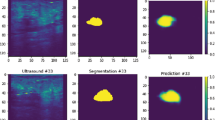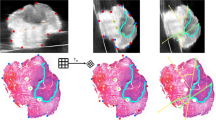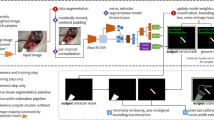Abstract
Tumor infiltration of the recurrent laryngeal nerve (RLN) is a contraindication for robotic thyroidectomy and can be difficult to detect via standard laryngoscopy. Ultrasound (US) is a viable alternative for RLN detection due to its safety and ability to provide real-time feedback. However, the tininess of the RLN, with a diameter typically less than 3 mm, poses significant challenges to the accurate localization of the RLN. In this work, we propose a knowledge-driven framework for RLN localization, mimicking the standard approach surgeons take to identify the RLN according to its surrounding organs. We construct a prior anatomical model based on the inherent relative spatial relationships between organs. Through Bayesian shape alignment (BSA), we obtain the candidate coordinates of the center of a region of interest (ROI) that encloses the RLN. The ROI allows a decreased field of view for determining the refined centroid of the RLN using a dual-path identification network, based on multi-scale semantic information. Experimental results indicate that the proposed method achieves superior hit rates and substantially smaller distance errors compared with state-of-the-art methods.
H. Dou and L. Han contributed equally to this work.
Access this chapter
Tax calculation will be finalised at checkout
Purchases are for personal use only
Similar content being viewed by others
References
Chandrasekhar, S.S., et al.: Clinical practice guideline: improving voice outcomes after thyroid surgery. Otolaryngol.-Head Neck Surg. 148, 1–37 (2013)
Cheng, B., et al.: Panoptic-deeplab: a simple, strong, and fast baseline for bottom-up panoptic segmentation. In: Computer Vision and Pattern Recognition (2020)
Dionigi, G., Boni, L., Rovera, F., Rausei, S., Castelnuovo, P., Dionigi, R.: Postoperative laryngoscopy in thyroid surgery: proper timing to detect recurrent laryngeal nerve injury. Langenbecks Arch. Surg. 395, 327–331 (2010)
He, K., Zhang, X., Ren, S., Sun, J.: Deep residual learning for image recognition. In: Computer Vision and Pattern Recognition (2016)
He, Y., Li, Z., Yang, Y., Lei, J., Peng, Y.L.: Preoperative visualized ultrasound assessment of the recurrent laryngeal nerve in thyroid cancer surgery: reliability and risk features by imaging. Can. Manage. Res. 13, 7057–7066 (2021)
Horng, M.H., Yang, C.W., Sun, Y.N., Yang, T.H.: Deepnerve: a new convolutional neural network for the localization and segmentation of the median nerve in ultrasound image sequences. Ultrasound Med. Biol. 46, 2439–2452 (2020)
Lee, J., Chung, W.Y.: Robotic surgery for thyroid disease. Eur. Thyroid J. 2, 93–101 (2013)
Liu, Z., et al.: Swin transformer: hierarchical vision transformer using shifted windows. Ar\({\rm Xiv}\): Computer Vision and Pattern Recognition (2021)
Liu, Z., Mao, H., Wu, C.Y., Feichtenhofer, C., Darrell, T., Xie, S.: A convnet for the 2020s. arXiv preprint arXiv:2201.03545 (2022)
Meyer, P., Lintingre, P.F., Pesquer, L., Poussange, N., Silvestre, A., Dallaudière, B.: The median nerve at the carpal tunnel \(\ldots \) and elsewhere. J. Belgian Soc. Radiol. 102, 17–17 (2018)
Romera-Paredes, B., Torr, P.H.S.: Recurrent instance segmentation. In: Leibe, B., Matas, J., Sebe, N., Welling, M. (eds.) ECCV 2016. LNCS, vol. 9910, pp. 312–329. Springer, Cham (2016). https://doi.org/10.1007/978-3-319-46466-4_19
Ronneberger, O., Fischer, P., Brox, T.: U-Net: convolutional networks for biomedical image segmentation. In: Navab, N., Hornegger, J., Wells, W.M., Frangi, A.F. (eds.) MICCAI 2015. LNCS, vol. 9351, pp. 234–241. Springer, Cham (2015). https://doi.org/10.1007/978-3-319-24574-4_28
Tiel, R., Filler, A.G.: Nerve injuries of the lower extremity (2011)
Ulyanov, D., Vedaldi, A., Lempitsky, V.: Instance normalization: the missing ingredient for fast stylization. arXiv preprint arXiv:1607.08022 (2016)
Van Boxtel, J., Vousten, V., Pluim, J., Rad, N.M.: Hybrid deep neural network for brachial plexus nerve segmentation in ultrasound images. In: 2021 29th European Signal Processing Conference (EUSIPCO), pp. 1246–1250. IEEE (2021)
Wojtczak, B., Kaliszewski, K., Sutkowski, K., Bolanowski, M., Barczyński, M.: A functional assessment of anatomical variants of the recurrent laryngeal nerve during thyroidectomies using neuromonitoring. Endocrine 59(1), 82–89 (2017). https://doi.org/10.1007/s12020-017-1466-3
Wong, K.P., Lang, B.H.H.: Endoscopic thyroidectomy: a literature review and update. Current Surgery Reports 1, 7–15 (2013)
Wu, H., Liu, J., Wang, W., Wen, Z., Qin, J.: Region-aware global context modeling for automatic nerve segmentation from ultrasound images. In: National Conference on Artificial Intelligence (2021)
Xu, B., Wang, N., Chen, T., Li, M.: Empirical evaluation of rectified activations in convolutional network. arXiv preprint arXiv:1505.00853 (2015)
Zhao, H., Shi, J., Qi, X., Wang, X., Jia, J.: Pyramid scene parsing network. In: Proceedings of the IEEE Conference on Computer Vision and Pattern Recognition, pp. 2881–2890 (2017)
Acknowledgement
This work was supported by the National Natural Science Foundation of China under Grant No. 62101365 and the startup foundation of Nanjing University of Information Science and Technology. Haoran Dou was funded by the Royal Academy of Engineering Chair in Emerging Technologies Scheme (CiET1819/19). Luyi Han was funded by Chinese Scholarship Council (CSC) scholarship. Alejandro F. Frangi was funded by the Royal Academy of Engineering (INSILEX CiET1819/19), Engineering and Physical Sciences Research Council (EPSRC) programs TUSCA EP/V04799X/1, and the Royal Society Exchange Programme CROSSLINK IES\(\backslash \)NSFC\(\backslash \)201380. Jun Xu was funded by the National Natural Science Foundation of China (Nos. U1809205, 62171230, 92159301, 61771249, 91959207, 81871352).
Author information
Authors and Affiliations
Corresponding author
Editor information
Editors and Affiliations
Rights and permissions
Copyright information
© 2022 The Author(s), under exclusive license to Springer Nature Switzerland AG
About this paper
Cite this paper
Dou, H. et al. (2022). Localizing the Recurrent Laryngeal Nerve via Ultrasound with a Bayesian Shape Framework. In: Wang, L., Dou, Q., Fletcher, P.T., Speidel, S., Li, S. (eds) Medical Image Computing and Computer Assisted Intervention – MICCAI 2022. MICCAI 2022. Lecture Notes in Computer Science, vol 13434. Springer, Cham. https://doi.org/10.1007/978-3-031-16440-8_25
Download citation
DOI: https://doi.org/10.1007/978-3-031-16440-8_25
Published:
Publisher Name: Springer, Cham
Print ISBN: 978-3-031-16439-2
Online ISBN: 978-3-031-16440-8
eBook Packages: Computer ScienceComputer Science (R0)





